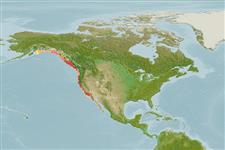>
Perciformes/Scorpaenoidei (Scorpionfishes) >
Sebastidae (Rockfishes, rockcods and thornyheads) > Sebastinae
Etymology: Sebastes: Greek, sebastes = august, venerable (Ref. 45335); jordani: Named after David Starr Jordan, eminent U.S. ichthyologist and educator (Ref. 6885).
More on author: Gilbert.
Environment: milieu / climate zone / depth range / distribution range
Écologie
marin démersal; profondeur 0 - 350 m (Ref. 6793). Subtropical; 60°N - 30°N, 138°W - 115°W
Eastern Pacific: Vancouver Island in British Columbia, Canada to northern Baja California, Mexico. Reported from Granite Island, off Kenai Peninsula, Alaska (Ref. 27437).
Length at first maturity / Taille / Poids / Âge
Maturity: Lm 14.0, range 12 - ? cm
Max length : 32.0 cm TL mâle / non sexé; (Ref. 2850); âge max. reporté: 31 années (Ref. 39247)
Description synthétique
Morphologie | Morphométrie
Épines dorsales (Total): 13; Rayons mous dorsaux (Total): 13-16; Épines anales 3; Rayons mous anaux: 8 - 11; Vertèbres: 26. Head spines weak - nasal, preocular, postocular, tympanic and parietal spines present, supraocular, coronal and nuchal spines absent (Ref. 27437). Body slender and elongate; vent midway between origins of pelvic and anal fins (Ref. 27437). Posterior margin of caudal fin deeply indented (Ref. 6885). Greenish pink dorsally, fading to light ventrally (Ref. 27437). Branchiostegal rays: 7 (Ref. 36715).
Found in a wide range of habitats, sometimes in large schools well offshore and off bottom (Ref. 2850). Juveniles are pelagic (Ref. 36715). Adults feed on planktonic animals, mainly krill (Ref. 2850). Viviparous, with planktonic larvae (Ref. 36715). A very important prey species for predatory fishes and marine mammals (Ref. 2850). Not marketed due to its small size (Ref. 2850).
Eschmeyer, W.N., E.S. Herald and H. Hammann, 1983. A field guide to Pacific coast fishes of North America. Boston (MA, USA): Houghton Mifflin Company. xii+336 p. (Ref. 2850)
Statut dans la liste rouge de l'IUCN (Ref. 130435)
Menace pour l'homme
Harmless
Utilisations par l'homme
Pêche sportive: oui
Plus d'informations
RéférencesAquacultureProfil d'aquacultureSouchesGénétiqueElectrophoresesHéritabilitéPathologiesTraitementNutrientsMass conversion
CollaborateursImagesStamps, Coins Misc.SonsCiguateraVitesseType de nageSurface branchialeOtolithesCerveauxVision
Outils
Articles particuliers
Télécharger en XML
Sources Internet
Estimates based on models
Preferred temperature (Ref.
123201): 7 - 9.7, mean 8.2 °C (based on 40 cells).
Phylogenetic diversity index (Ref.
82804): PD
50 = 0.5000 [Uniqueness, from 0.5 = low to 2.0 = high].
Bayesian length-weight: a=0.00389 (0.00180 - 0.00842), b=3.12 (2.94 - 3.30), in cm total length, based on all LWR estimates for this body shape (Ref.
93245).
Niveau trophique (Ref.
69278): 3.2 ±0.35 se; based on food items.
Résilience (Ref.
120179): Milieu, temps minimum de doublement de population : 1,4 à 4,4 années (tm=2.5; K=0.18-0.30; tmax=31, Fec=7,000).
Fishing Vulnerability (Ref.
59153): Moderate vulnerability (43 of 100).
